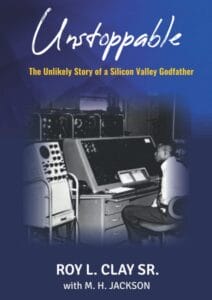Born in Kinloch, Mo., Clay grew up in a home without electricity and plumbing. His first teacher, he said, “inspired me to do well. By the time I left that little school, I thought I could learn to do anything.” He won a scholarship to study mathematics at Saint Louis University, graduating in 1951. His first job was teaching school, but he really wanted to find a job in tech. He was qualified for an opening at McDonnell Aircraft Corp., but a friendly employee took him aside to break something to him: “Mr. Clay,” he was told, “I’m very sorry, we don’t hire professional Negroes.” But he managed to get a job at IBM supporting computer systems at customer locations — including at McDonnell Aircraft Corp.
After teaching himself to write software, in 1958 Clay was hired as a programmer at the University of California Radiation Laboratory, Livermore Branch — now known as the Lawrence Livermore National Laboratory — creating a tracking system to study the spread of radiation through the atmosphere in the aftermath of a nuclear explosion. While there, Clay was introduced to David Packard, co-founder of Hewlett-Packard. He encouraged Clay to apply for a job. But H-P didn’t make computers, so in 1962, Clay instead became a software engineer for Control Data Corp. By 1965, H-P was ready to make computers, and Packard himself recruited Clay to lead the development project. The result was the H-P 2100 series, starting with the 16-bit 2116A minicomputer. It was first demonstrated at the Joint Computer Conference in San Francisco in November 1966.
Two years later, when 2100-model computers were packaged with a BASIC language-based timesharing system — the first in the industry — they were marketed as the H-P 2000 series. The first, the 2000A, could handle up to 16 users at the same time. As the machines became more capable, a dual-processor 2000B was introduced, followed by the even larger 2000C, which could handle up to 32 simultaneous users. It was an H-P 2000C that my Silicon Valley junior high school leased time on to teach students about computers, starting in 1971 (that story is in my blog), which set me on a course to become one of the first full-time online publishers in 1994. Yet I had never even heard of Clay until today, when I spotted a very brief obit and started researching him.

As an H-P manager, “I decided that the hours of greatest communication were between 10:00 a.m. and 2:00 p.m.,” Clay wrote years later in his autobiography. “Therefore, I asked that everyone be in the office between those hours, to avoid having trouble with scheduling meetings. The remaining hours worked were at the discretion of each individual employee.” H-P co-founder Bill Hewlett was incensed. “Without exception, an H-P employee should report to work at 7:45 a.m.,” Hewlett told Clay in an angry phone call, “take a coffee break between 9:35 a.m. and 9:45 a.m., take lunch between 11:45 a.m. and 12:30 p.m., take a coffee break between 2:35 p.m. and 2:45 p.m., and leave work at 4:30 p.m.!” But Hewlett calmed down when he needed computer support at 10:00 p.m., and one of Clay’s group happened to still be at work to help him. “When word got around in the industry about my ‘flex-time’ approach to managing my employees,” Clay wrote, “I started to get calls from many professionals in the field who were looking for new job opportunities. It made recruiting excellent employees a lot easier.” He didn’t realize until later just how innovative the idea was. “Flexible work hours slowly became a part of the culture at H-P while I was there.” A few years after he left, he read an article which “stated that H-P had invented ‘flex-time’.”

Clay rose to be the first director of the H-P Research and Development Computer Group. When Tom Perkins, General Manager of H-P’s Computer Division, resigned in 1971 to co-found the Silicon Valley venture capital firm Kleiner Perkins Caufield & Byers, Clay took over that position too, but left H-P a short time later: Perkins brought Clay in as a consultant to help identify good investments in early tech companies. Three of the companies he suggested to Perkins were major hits: Tandem Computers, Compaq, and Intel together returned billions on the VC investments. Along the way, Clay recruited math and science graduates from historically Black universities and colleges.
In 1973, Clay became the first non-white member of the city council of Palo Alto, serving until 1979. But he didn’t leave tech: Clay learned that Underwriters Laboratories would be requiring electrical safety certification of computer systems. He partnered with H-P, AT&T, IBM, Tektronix, and Xerox to come up with automated hipot (high potential) “dielectric withstand” test equipment for electronic systems. He founded a company, Rod-L, to do it. The equipment was “designed to ensure that a product is electrically safe from shock or fire hazard should there be a voltage surge on the input power line of the product,” the company said. It was “the first Hipot Testers to be awarded the Consumer Product Safety Award.” In 2003, Clay was inducted into the Silicon Valley Engineering Hall of Fame.
“With education, you own something that can’t be taken from you,” Clay’s mother had told him. “You will face racism the rest of your life, but don’t ever let that be a reason why you don’t succeed.” He passed that along. “My kids and grandkids have the same mentality that I did back in the 50s and 60s,” he said. “Nothing is going to stop them from achieving their goals.” He finally retired in 2015, at 86 years old. Roy L. Clay Sr. died September 22, at 95.
